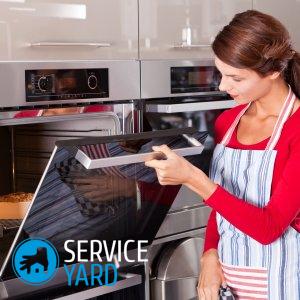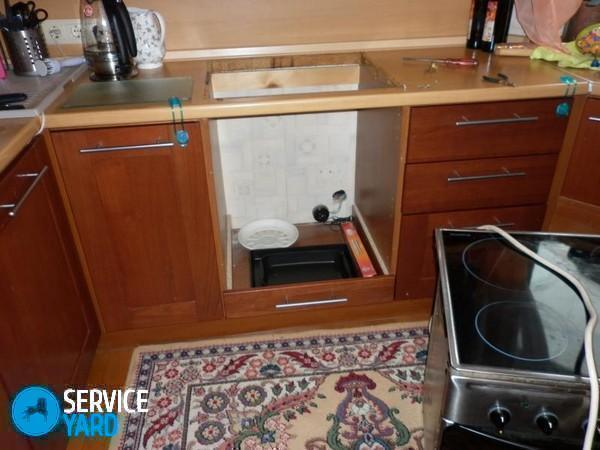Where to install the outlet for the oven?

Today, many people install hobs instead of a full stove, and then install a separate oven. In some situations, this is a very rational approach when arranging a kitchen. When a box is designed for an oven, even furniture collectors sometimes forget about one little thing, however, very important. And about where to install the outlet for the oven, you have to think immediately before using it. Often use a conventional extension cord, but it is not always possible to use it. Let's consider all in more detail.
to contents ↑Rules for installing an outlet for the oven
Before you start installing the outlet, you should study the recommendations indicated in the passport for household appliances. The passport contains information on the overall performance of electrical equipment and on the conditions for its connection to the power grid.
Prohibited locations
In some areas, installing the outlet is strictly prohibited. They are represented by:
- Places where water may enter. Most often this is a sink or sewer.
Important! If the outlet is installed under the sink, it must be reliably protected from moisture.
- Places located just behind the oven. Using it will be simply inconvenient.
- Immediately near the hob.
Optimal Placements
Be sure to consider that the outlet must be placed at a level below the countertop. It is best to use a box to place it.
Important! Be sure to consider the presence of free space near the outlet, as access to it should be free. This nuance is very important for safety, since even a properly installed outlet can break or catch fire. In case of danger, a quick disconnection of the device from the mains is required.
You can install the outlet for the oven in the immediate vicinity of the exhaust hood or on the working wall of the kitchen headset.
to contents ↑Extension cord application
An extension cord is used to connect the oven to a power outlet. Therefore, the distance between them does not matter much. Of course, I do not want the extension cord to be striking. To do this, it can be hidden behind the kitchen furniture.
In the event that the extension cord cannot be used for any reason, it is thought over in advance how to install the outlet to the oven. The distance between them in this case should be no more than one meter.
to contents ↑Important! To make the installation correctly, it is better to contact specialists. They will not only choose the most suitable place for placement, but also expertly complete the installation in accordance with all safety rules.
Connection options
To connect the oven, use the following schemes:
- Single phase. It is used if the room is equipped with only a single-phase network with a voltage of 220 V.
- Two-phase or three-phase. It is used to increase power and at the same time increase efficiency.
The manufacturer can not predict in advance which scheme the consumer will use, so there is no standard electric plug on the hob.
to contents ↑Important! The oven is not such a powerful device, therefore, for its normal operation, a household electrical network is designed, the voltage in which is 220 V.That is why a standard Euro plug with grounding contacts in the construction comes with such equipment.
How to connect the line to the electrical panel?
When the oven is connected to the electrical panel, it is recommended to select a separate line for it, which is protected by the circuit breaker:
- If the rated current of the device is 16A, a 25 A circuit breaker is installed.
- If - 32A, the switch must be taken at 40A.
Important! A protective earth connection is required. The oven power cable has one ground conductor connected to the appliance body. It is removed in order to connect with the corresponding contact on the electric plug. The insulation color of such a core is yellow-green.
 Sometimes the output wires may have the same insulation or the marking is not the same as usual.
Sometimes the output wires may have the same insulation or the marking is not the same as usual.
Important! If the connection is done independently, you must make sure that all the terminals are connected correctly.
In order to detect the phase conductor, you can use an ordinary indicator screwdriver. But in order not to confuse the grounding and neutral wire, you will have to use a tester.
To determine the phase, neutral and ground wires, you can use the following algorithm:
- Using an indicator screwdriver, in the place where the electrical outlet will be installed, you should determine the phase wire. It must be marked with electrical tape or signed.
- An indicator screwdriver is also used to determine the neutral wire on the switchboard.
- To detect the grounding conductor, you need to carefully inspect the metal housing of the shield or a special block. Usually it connects to them.
- Next, the phase and zero wires are disconnected from the input automaton. Then they need to be interconnected.
- On the device side, you need to check the resistance with a tester, which is formed between the phase wire and the two remaining ones. When the resistance value is minimal, this indicates the detection of a neutral wire.
- After identifying and signing all the wires, you can install the outlet and connect the cable to the circuit breaker.
How to choose a power outlet?
Before deciding which outlet to choose for the hob, you should carefully study the characteristics of the technique. The connection of both hobs and ovens can be either single- or three-phase. The power of such devices varies from 2.5 to 10 kW.
Important! Plugs and, often, cables are not included with hob surfaces, so they can be directly connected to the shield. But although the plug is not used, it is necessary to put an RCD and an automatic switch.
Which outlet to choose?
- For single-phase connection of the device with power up to 3.5 kW, a standard 16A socket is used. Most often, ovens are already sold with an ordinary wire and a sixteen-amp plug, so only an outlet is required. And in the case of the hob, the purchase of all components is required.
- More powerful models, 3.6-7 kW, require connecting to a 32 A power outlet. In some cases, you will need to purchase a special 32A plug.
- The voltage for a three-phase connection is 380 V. In the event that the appliance is not more powerful than 3.5 kW, a 20A outlet is sufficient. A powerful hob will require 32A.
to contents ↑Important! Such a technique is usually equipped with plugs and sockets with a grounding contact, so they have a larger number of holes and pins. Single-phase are represented by three: two supply and ground, three-phase - five: three supply, ground and neutral. This can not be neglected, since the lack of grounding is life threatening.
Stock footage
As you can see, it’s not so easy to choose an outlet for the oven. Most often, this business is still trusted by professional electricians. However, we are confident that this article was useful in order to monitor the work performed.
- How to choose a vacuum cleaner taking into account the characteristics of the house and coatings?
- What to look for when choosing a water delivery
- How to quickly create comfort at home - tips for housewives
- How to choose the perfect TV - useful tips
- What to look for when choosing blinds
- What should be running shoes?
- What useful things can you buy in a hardware store
- Iphone 11 pro max review
- Than iPhone is better than Android smartphones



